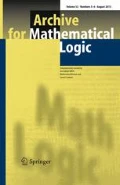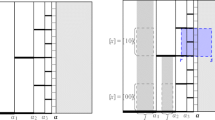Abstract
Consider a randomness notion \({\mathcal{C}}\). A uniform test in the sense of \({\mathcal{C}}\) is a total computable procedure that each oracle X produces a test relative to X in the sense of \({\mathcal{C}}\). We say that a binary sequence Y is \({\mathcal{C}}\)-random uniformly relative to X if Y passes all uniform \({\mathcal{C}}\) tests relative to X. Suppose now we have a pair of randomness notions \({\mathcal{C}}\) and \({\mathcal{D}}\) where \({\mathcal{C} \subseteq \mathcal{D}}\), for instance Martin-Löf randomness and Schnorr randomness. Several authors have characterized classes of the form Low(\({\mathcal{C}, \mathcal{D}}\)) which consist of the oracles X that are so feeble that \({\mathcal{C} \subseteq \mathcal{D}^X}\). Our goal is to do the same when the randomness notion \({\mathcal{D}}\) is relativized uniformly: denote by Low \({\star(\mathcal{C},\mathcal{D})}\) the class of oracles X such that every \({\mathcal{C}}\)-random is uniformly \({\mathcal{D}}\)-random relative to X. (1) We show that \({X\in Low ^\star}\)(MLR, SR) if and only if X is c.e. tt-traceable if and only if X is anticomplex if and only if X is Martin-Löf packing measure zero with respect to all computable dimension functions. (2) We also show that \({X\in Low^\star}\) (SR, WR) if and only if X is computably i.o. tt-traceable if and only if X is not totally complex if and only if X is Schnorr Hausdorff measure zero with respect to all computable dimension functions.
Similar content being viewed by others
References
Barmpalias G., Downey R., Ng K.M.: Jump inversions inside effectively closed sets and applications to randomness. J. Symb. Logic 76(2), 491–518 (2011)
Bienvenu L., Miller J.S.: Randomness and lowness notions via open covers. Ann. Pure Appl. Logic 163, 506–518 (2012)
Binns S.: Small \({\Pi^{0}_{1}}\) classes. Arch. Math. Logic 45(4), 393–410 (2006)
Binns S.: Hyperimmunity in \({{2}^{\mathbb{N}}}\). Notre Dame J. Form. Log. 48(2), 293–316 (2007)
Binns S.: \({\Pi^{0}_{1}}\) classes with complex elements. J. Symb. Logic 73(4), 1341–1353 (2008)
Binns S., Kjos-Hanssen B.: Finding paths through narrow and wide trees. J. Symb. Logic 74(1), 349–360 (2009)
Brattka, V.: Computability over topological structures. In: Cooper, S.B., Goncharov, S.S. (eds.) Computability and Models, pp. 93–136. Kluwer, New York (2003)
Brattka, V., Hertling, P., Weihrauch, K.: A tutorial on computable analysis. In: Cooper, S.B., Löwe, B., Sorbi, A. (eds.) New Computational Paradigms, pp. 425–491. Springer, Berlin (2008)
Calude, C.S., Coles, R.J.: Program-size complexity of initial segments and domination relation reducibility. In: Karhumäki, J., Hauer, H., Păun, G., Rozenberg, G. (eds.) Jewels and Forever, pp. 225–237. Springer, Berlin (1999)
Chaitin G.J.: Nonrecursive infinite strings with simple initial segments. IBM J. Res. Dev. 21, 350–359 (1977)
Diamondstone, D., Kjos-Hanssen, B.: Members of random closed sets. In: Mathematical Theory and Computational Practice, pp. 144–153. Springer, Berlin (2009)
Downey R., Griffiths E., LaForte G.: On Schnorr and computable randomness, martingales, and machines. MLQ Math. Log. Q. 50(6), 613–627 (2004)
Downey R., Hirschfeldt D.R.: Algorithmic Randomness and Complexity. Springer, Berlin (2010)
Downey R., Nies A., Weber R., Yu L.: Lowness and \({\Pi^{0}_{2}}\) nullsets. J. Symb. Logic 71(3), 1044–1052 (2006)
Downey R.G., Griffiths E.J.: Schnorr randomness. J. Symb. Logic 69(2), 533–554 (2004)
Downey, R.G., Hirschfeldt, D.R., Nies, A., Stephan, F.: Trivial reals. In: Downey, R.G., Ding, D., Tung, S.P., Qiu, Y.H., Yasugi, M. (eds.) Proceedings of the 7th and 8th Asian Logic Conferences, pp. 103–131. Singapore University Press and World Scientific, Singapore (2003)
Downey, R.G., Merkle, W., Reimann, J.: Schnorr dimension. In: Barry Cooper, S. et al. (ed.) New Computational Paradigms, First Conference on Computability in Europe, CiE 2005, Lecture Notes in Comput. Sci., vol. 3526, pp. 96–105. Springer, Berlin (2005)
Franklin J., Greenberg N., Stephan F., Wu G.: Anti-complex sets and reducibilities with tiny use. J. Symb. Logic 78(4), 1307–1327 (2013)
Franklin J., Stephan F.: Van Lambalgen’s theorem and high degrees. Notre Dame J. Form. Log. 52(2), 173–185 (2011)
Franklin J.N.Y.: Hyperimmune-free degrees and Schnorr triviality. J. Symb. Logic 73(3), 999–1008 (2008)
Franklin J.N.Y.: Schnorr trivial reals: a construction. Arch. Math. Log. 46(7–8), 665–678 (2008)
Franklin, J.N.Y.: Lowness and highness properties for randomness notions. In: Arai, T. et al. (ed.) Proceedings of the 10th Asian Logic Conference, pp. 124–151. World Scientific, Singapore (2010)
Franklin J.N.Y.: Schnorr triviality and genericity. J. Symb. Logic 75(1), 191–207 (2010)
Franklin J.N.Y., Stephan F.: Schnorr trivial sets and truth-table reducibility. J. Symb. Logic 75(2), 501–521 (2010)
Greenberg N., Miller J.S.: Lowness for Kurtz randomness. J. Symb. Logic 74, 665–678 (2009)
Higuchi K., Kihara T.: On effectively closed sets of effective strong measure zero. Ann. Pure Appl. Logic 165(9), 1445–1469 (2014)
Hirschfeldt D., Nies A., Stephan F.: Using random sets as oracles. J. Lond. Math. Soc. 75, 610–622 (2007)
Hölzl, R., Merkle, W.: Traceable sets. Theoret. Comput. Sci. 323, 301–315 (2010)
Kanovich M.I.: On the complexity of enumeration and decision of predicates. Sov. Math. Dokl. 11, 17–20 (1970)
Kihara T., Miyabe K.: Uniform Kurtz randomness. J. Log. Comput. 24(4), 863–882 (2014)
Kjos-Hanssen B., Merkle W., Stephan F.: Kolmogorov complexity and the recursion theorem Trans. Am. Math. Soc. 363(10), 5465–5480 (2011)
Kjos-Hanssen B., Miller J.S., Solomon D.R.: Lowness notions, measure, and domination. J. Lond. Math. Soc. 85(3), 869–888 (2012)
Kjos-Hanssen B., Nies A.: Superhighness. Notre Dame J. Form. Log. 50, 445–452 (2009)
Kjos-Hanssen B., Nies A., Stephan F.: Lowness for the class of Schnorr random reals. SIAM J. Comput. 35(3), 647–657 (2005)
Kučera A.: On relative randomness. Ann. Pure Appl. Logic 63, 61–67 (1993)
Kučera A., Terwijn S.: Lowness for the class of random sets. J. Symb. Logic 64, 1396–1402 (1999)
Merkle W., Miller J., Nies A., Reimann J., Stephan F.: Kolmogorov–Loveland randomness and stochasticity. Ann. Pure Appl. Logic 138(1–3), 183–210 (2006)
Miyabe, K.: Schnorr triviality and its equivalent notions. Theory Comput. Syst. (to appear)
Miyabe K.: Truth-table Schnorr randomness and truth-table reducible randomness. MLQ Math. Log. Q. 57(3), 323–338 (2011)
Miyabe, K., Rute, J.: Van Lambalgen’s theorem for uniformly relative Schnorr and computable randomness. In: Proceedings of the Twelfth Asian Logic Conference, pp. 251–270 (2013)
Nies A.: Lowness properties and randomness. Adv. Math. 197, 274–305 (2005)
Nies A.: Computability and Randomness. Oxford University Press, USA (2009)
Nies A., Stephan F., Terwijn S.: Randomness, relativization and Turing degrees. J. Symb. Logic 70, 515–535 (2005)
Odifreddi, P.: Classical Recursion Theory, vol. 1. North-Holland, Amsterdam (1990)
Odifreddi, P.: Classical Recursion Theory, vol. 2. North-Holland, Amsterdam (1999)
Pawlikowski J.: A characterization of strong measure zero sets. Israel J. Math. 93(1), 171–183 (1996)
Reimann, J.: Computability and Fractal Dimension. Ph.D. Thesis, Universität Heidelberg (2004)
Soare R.I.: Recursively Enumerable Sets and Degrees. Perspectives in Mathematical Logic. Springer, Berlin (1987)
Solovay, R.: Draft of Paper (or Series of Papers) on Chaitin’s Work. Unpublished Notes (1975), p. 215
Stephan F., Yu L.: Lowness for weakly 1-generic and Kurtz-random. Lect. Notes Comput. Sci. 3959, 756–764 (2006)
Terwijn S.A., Zambella D.: Computational randomness and lowness. J. Symb. Logic 66(3), 1199–1205 (2001)
van Lambalgen, M.: Random Sequences. Ph.D. Thesis, University of Amsterdam (1987)
Weihrauch K.: Computable Analysis: An Introduction. Springer, Berlin (2000)
Weihrauch K., Grubba T.: Elementary computable topology. J. UCS 15(6), 1381–1422 (2009)
Yu L.: When van Lambalgen’s theorem fails. Proc. Am. Math. Soc. 135(3), 861–864 (2007)
Zambella, D.: On Sequences with Simple Initial Segments. Tech. rep., Univ. Amsterdam (1990). ILLC Technical Report ML 1990-05
Author information
Authors and Affiliations
Corresponding author
Rights and permissions
About this article
Cite this article
Kihara, T., Miyabe, K. Unified characterizations of lowness properties via Kolmogorov complexity. Arch. Math. Logic 54, 329–358 (2015). https://doi.org/10.1007/s00153-014-0413-8
Received:
Accepted:
Published:
Issue Date:
DOI: https://doi.org/10.1007/s00153-014-0413-8




